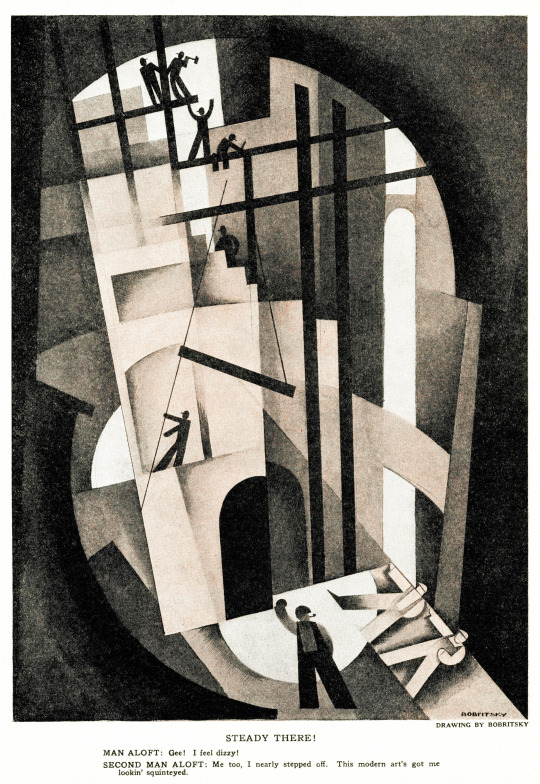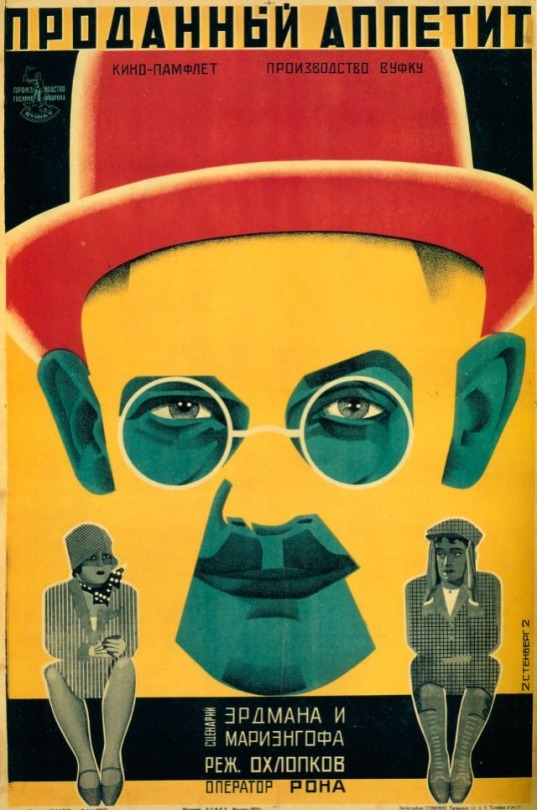#constructivist art
Explore tagged Tumblr posts
Text

Vladimir Bobritsky (Bobri) (1898-1986), ''New Masses'', Vol. 1, #1, May 1926 Source
#Vladimir Bobri#Vladimir Bobritsky#Bobri#ukranian artist#new masses#constructivist art#vintage illustration#vintage art
97 notes
·
View notes
Text

Stenberg Brothers, Cafe Fanconi, 1927
#georgii stenberg#vladimir stenberg#stenberg brothers#movie art#russian movies#movie posters#russian artist#russian art#russian avant garde#constructivist#constructivist art#constructivism#modern art#art history#aesthetictumblr#tumblraesthetic#tumblrpic#tumblrpictures#tumblr art#aesthetic#beauty#tumblrstyle
30 notes
·
View notes
Text

Erik H. Olson (Nov. 29, 1909 - 1995) was an autodidact Swedish artist. His main body of works consists of sculptures such as this one, drawing on a constructivist idiom, but playing with light and color. His work is found at the Tate Gallery in London and MoMA in New York, as well as major Swedish museums.
Above: Light Wavelength Composition, 1958 - polarized glass, plexiglass, and Bakelite (Moderna Museet)
#art#swedish artist#erik h. olson#autodidact artist#1950s#constructivist art#plexiglass sculpture#moderna museet#moma#tate gallery
9 notes
·
View notes
Text

Constructivist artworks by El Lissitzky, Carl Grossburg and Willi Baumeister, in an article about the Essen Folkwang Museum's Art and Technology exhibit in the August 1928 Moderne Welt.
(source: Österreichische Nationalbibliothek)
#constructivist art#constructivism#1920s art#willi baumeister#el lissitzky#carl grossburger#essen folkwang museum#bauhaus
5 notes
·
View notes
Text
Aleksey Gan (1923)

"Hooray for demonstrating everyday life!" - a book for cinema makers written and designed by Aleksey Gan (1923)
#Aleksey Gan#constructivist#constructivism#russian avant garde#constructivist art#poster art#propaganda art#agitprop#modern art#art history#aesthetictumblr#tumblraesthetic#tumblrpic#tumblrpictures#tumblr art#tumblrstyle#artists on tumblr
164 notes
·
View notes
Text

Verena Loewensberg by Stephen Storm, 1936.
4 notes
·
View notes
Text
i love when cold war western authors are clearly definitely unbiased when writing about russian art
#saracasm#its just small sentence lmao but its so transparent#cant wait to get to the political art section#im done with futurists boys! which actually pretty clear and interesting to read#hello constructivists who have like 70 pages about them :(#readings logs#general art tag
15 notes
·
View notes
Text

Joaquín Torres-García (Uruguayan-Spanish 1874-1949) Constructive City with Universal Man, 1942. Oil on board, 31 7/16 x 40 in. | 79.9 x 101.5 cm. (Source: Guggenheim Museum, New York)
#art#artwork#modern art#contemporary art#modern artwork#contemporary artwork#20th century modern art#20th century contemporary art#abstract#abstract modernism#Constructivist#Constructivism#Concrete art movement#Guggenheim#Guggenheim museum#Uruguanyan art#modern Uruguayan art#contemporary Uruguayan art#Uruguayan artist#Uruguayan painter#Joaquín Torres-García
4 notes
·
View notes
Text



Constructivist Final Work
~
I am indecisive trying to pick what one I should draw on the nice paper >~<
All poses found on Pinterest.
#scribblyhelp#original art#art#helpfulscribbles#helpscribbles#original sketch#original#pencil sketch#traditional pencil drawing#traditinal drawing#traditional#traditional art#constructivist#constructivism
0 notes
Photo










(via Couvre-litundefined avec l'œuvre « "Symmetry of Expression: 2D Face Minimalism" » de l'artiste Art-Vortex-fr)
#findyourthing#redbubble#Abstraction Style constructiviste Minimalisme Visage Design unique Artistique Élégant Intriguant Géométrie Expression Symétrie Art contempor
0 notes
Text

herman de vries, my poetry is the world..., (bluestone and text in gold paint), 1974 [Kröller-Müller Museum, Otterlo. © herman de vries]
my poetry is the world i write it every day i rewrite it every day i eat it every day i read it every day the world is my chance it changes me every day my chance is my poetry

«'my poetry is the world...' was made by herman de vries in 1974 on the occasion of the first Symposion in Gorinchem, a periodically organized art event for constructivist and concrete art. The tile lay on the sidewalk in front of Kunstcentrum Badhuis in Gorinchem (run by Antoinette Hilgemann-de Stigter) from 1974 to 1984 and then from 1988 to 2008 in front of the gallery Art Affairs in Amsterdam. In 2015 Antoinette & Ewerdt Hilgemann donated the stone to the Kröller-Müller Museum, where it lies in the path to the sculpture garden of the where visitors can walk across it»
#art#sculpture#poetry#herman de vries#kunstcentrum badhuis#antoinette hilgemann de stigter#antoinette hilgemann#ewerdt hilgemann#kröller müller museum#1970s
60 notes
·
View notes
Text

Raoul Hausmann (1886-1971), 'Tatlin at Home', 1921 "Tatlin at Home depicts a prototype of “mechanical thought” rather than the actual representation of Vladimir Tatlin, one of the most important figures in Russian avant-garde, the key artist and architect of the Constructivist movement. Constructivism was devoted to making use of art only for practical, social purposes and Tatlin became renowned for his ambitious, utopian project of the Monument to the Third International. The important detail about Dada though is that their work was often infused with spontaneity and irrelevance, and in the present work Hausmann stays true to the Dadaist ideals and uses a found photograph of a random man to depict Tatlin! (yes, this is not Tatlin himself)" (Source) "Finished in 1920, Tatlin at Home presents a situation in which the human mind is controlled by rational, unemotional thought. Hausmann believed the source of the war that ravaged Europe was a result of a society that made decisions that were influenced too much by emotion....Emotion is what causes the human to make poor decisions. He is specifically disillusioned with the decision to start war. If the people would think with exact non-biased calculation, they would see the consequences of going to war. In a perfect world, the people would think rationally and there would be peace as a result." (Source)
53 notes
·
View notes
Text

Stenberg Brothers
The Sold Appetite
1928
#stenberg brothers#vladimir stenberg#georgii stenberg#russian movies#russian art#russian artist#russian avant garde#constructivist art#constructivist#constructivism#movie art#movie posters#modern art#art history#aesthetictumblr#tumblraesthetic#tumblrpic#tumblrpictures#tumblr art#aesthetic#beauty#tumblrstyle
14 notes
·
View notes
Text







Venice in the art of Alexandra Exter (1882-1949)
Carnival in Venice (oil on canvas) 1930s
Carnival Procession (oil on canvas)
Masked Figures by the Banks of a Venetian Canal (oil on canvas)
Venetian Masks (oil on panel)
Pulcinella (gouache on paper) late 1920s-30s
Venice (oil and sand on canvas) 1925
Venice, 1915
"Aleksandra Aleksandrovna Ekster, also known as Alexandra Exter, was a Russian and French painter and designer. As a young woman, her studio in Kiev attracted all the city's creative luminaries, and she became a figure of the Paris salons, mixing with Picasso, Braque and others. She is identified with the Russian/Ukrainian avant-garde, as a Cubo-futurist, Constructivist, and influencer of the Art Deco movement. She was the teacher of several School of Paris artists such as Abraham Mintchine, Isaac Frenkel Frenel and the film directors Grigori Kozintsev, Sergei Yutkevich among others." [x]
"Exter painted views of Florence, Genoa and Rome, but ‘most insistent and frequent were images of Venice. The city emerged in various forms: via the outlines of its buildings, in the ‘witchcraft of water’. In glimmering echoes of Renaissance painting, in costumes and masks and its carnivals’.
"Exter’s characteristic use of the bridge as a stage platform, seen most clearly in Carnival in Venice, is a legacy of her time as Tairov’s chief designer [Alexander Tairrov, director of Moscow's Kamerny Theatre]; the director believed in breaking up the flatness of the stage floor which the artist achieved for him by introducing arches, steps and mirrors. Even in her easel work, the emphasis is at all times on theatricality. Bridges are used as proscenium arches, the architecture creates a stage-like space in which to arrange her cast."
"For all her modernity, references to Venetian art of the past abound in these paintings. The masked figures are influenced by the Venetian artist Pietro Longhi, to whom Exter dedicated a series of works around this time. The incredible blues used in both Carnival Procession and Masked Figures by the Banks of a Venetian Canal are a direct reference to Titian, who was famed for his use of ultramarine, the pigment most associated with Venice’s history as the principal trading port with the East." [x]
"Exter had long since abandoned the Cubist syntax by 1925 but her sense of colour remained together with a strong conviction, shared with Léger, that a work of art should elicit a feeling of mathematical order. In its graceful interaction of fragmented planes and oscillation between emerging and receding elements, Venice (1925) echoes the more precise qualities that also appear in Léger's work at this time, both artists occupied with the continuous modulation of surfaces and the 'melody of construction' that Le Corbusier was still advocating in the 1930s. But while Exter subscribed to Léger's theory that 'a painting in its beauty must be equal to a beautiful industrial production', she never fully embraced the aesthetics of the machine and rejecting the common opposition between ancient and modern, her work often retains a classical edge - for example in these trefoil windows, arches and vaults. Human figures, which had been nearly absent from her Cubo-futurist paintings, also return in other works from this period."
"She was undoubtedly aware of the concept of 'defamiliarisation', a term first coined by the influential literary critic Viktor Shklovsky in 1917:
'The purpose of art is to impart the sensation of things as they are perceived and not as they are known. The technique of art is to make objects 'unfamiliar,' to make forms difficult to increase the difficulty and length of perception because the process of perception is an aesthetic end in itself and must be prolonged.'
An instance of this device is discernable in the present tight formation of the oars, seen from above. Like Braque and Picasso, Exter incorporates sand into certain areas of pigment to enhance the differentiation of surfaces, a technique also used to 'increase the length of perception'. The occasional lack of overlap between the boundaries of the textured surfaces and colour planes strengthens the paradoxical combination of tangible presence and elusive abstraction that makes Venice such a powerful work."
"Venetian subjects occur in Exter's work as early as 1915. A gigantic panneau of the city was one of the final works she produced in the Soviet Union and exhibited in the 1924 Venice Biennale." [x]
"The specific theme of the Commedia dell’Arte first appeared in Exter’s work in 1926 when the Danish film director Urban Gad approached her to design the sets and marionettes for a film which was to tell the story of Pulcinella and Colombina, transposing them from the Venice of Carlo Goldoni to contemporary New York. Pulcinella most likely relates to the artist’s subsequent experimentations on the theme of the Commedia dell’Arte. Pulcinella, who came to be known as Punch in England, is one of the classical characters of the Neapolitan puppetry. Typically depicted wearing a pointed hat and a mask, Pulcinella is an opportunist who always sides with the winner in any situation and fears no consequences." [x]
56 notes
·
View notes
Text
nothing makes it more clear how ideologically cooked from the inside out the CPSU was than the ~10-year shift from “we are going to make ultra high tech Constructivist workers clubs/art/industry and achieve postcapitalism” to “the power of the state must be venerated at every level so every building needs to look like a cathedral”
10 notes
·
View notes
Text

Rare transgender art sighting! ⚠️
In both life and art Anton Prinner defied rigid categorization and challenged the binary idea of gender. After studying at the Budapest academy, where Prinner, along with other women, was taught separately from men, the artist moved to Paris in the late 1920s and chose the name Anton. Here, Prinner made pioneering Constructivist sculptures and later created schematic bodies with mysterious, androgynous features. This work also revolves around questions relating to perception and expression and, with its title L'œil ou la cible (The Eye or the Target), it explores our individual way of seeing. "Je ne suis pas moi-même: je suis tout le monde" (I'm not myself: I'm everybody), Prinner wrote in a notebook.
The artist Pablo Picasso would address Prinner as ‘Monsieur Madame’ and would often introduce him to others as ‘the small man who makes large statues’. Although the former term would largely be considered insulting by today’s standards, Prinner and Picasso were great friends and by all accounts it appears that Prinner was wholly accepted in the circles he moved in. Indeed it seems he was never drawn into having public discussions about his gender identity at any point in his lifetime.

Anton Prinner in his studio, 1947. © Denise Colomb
33 notes
·
View notes